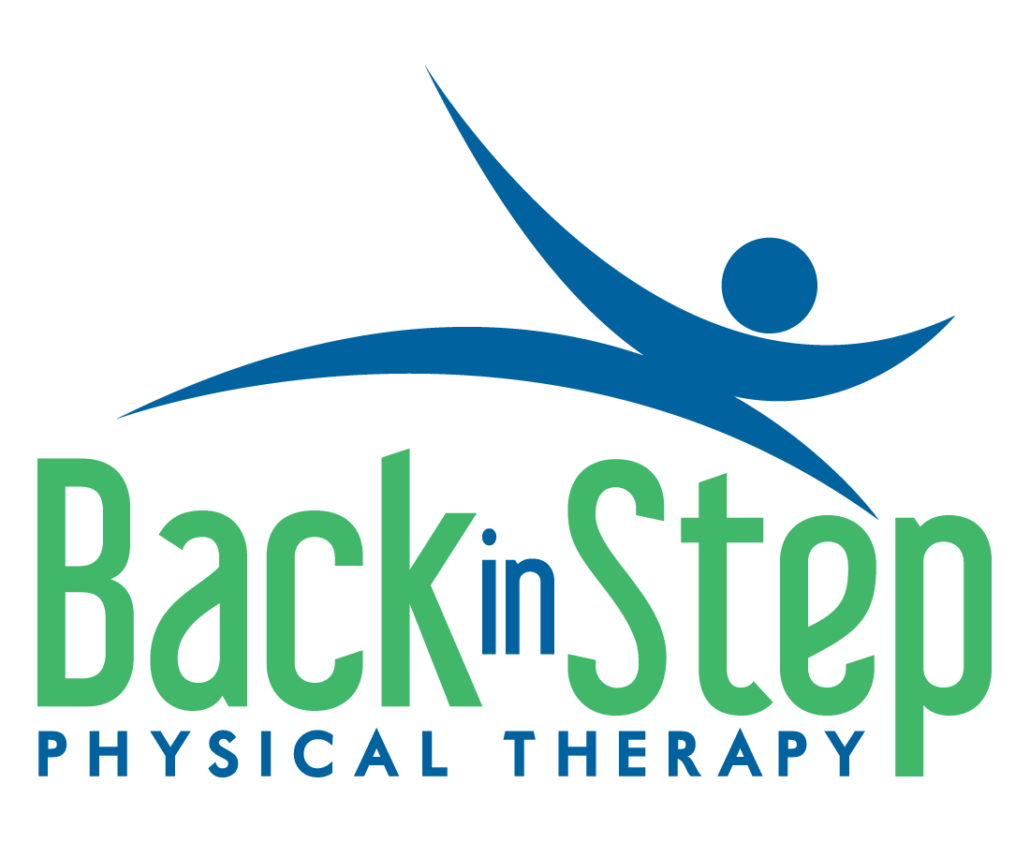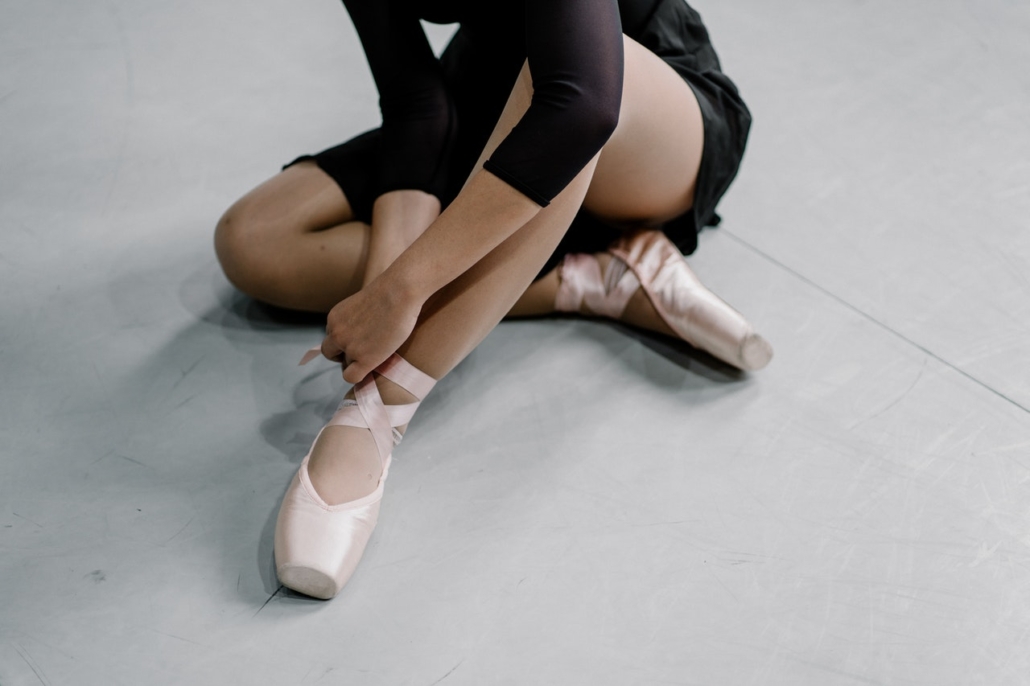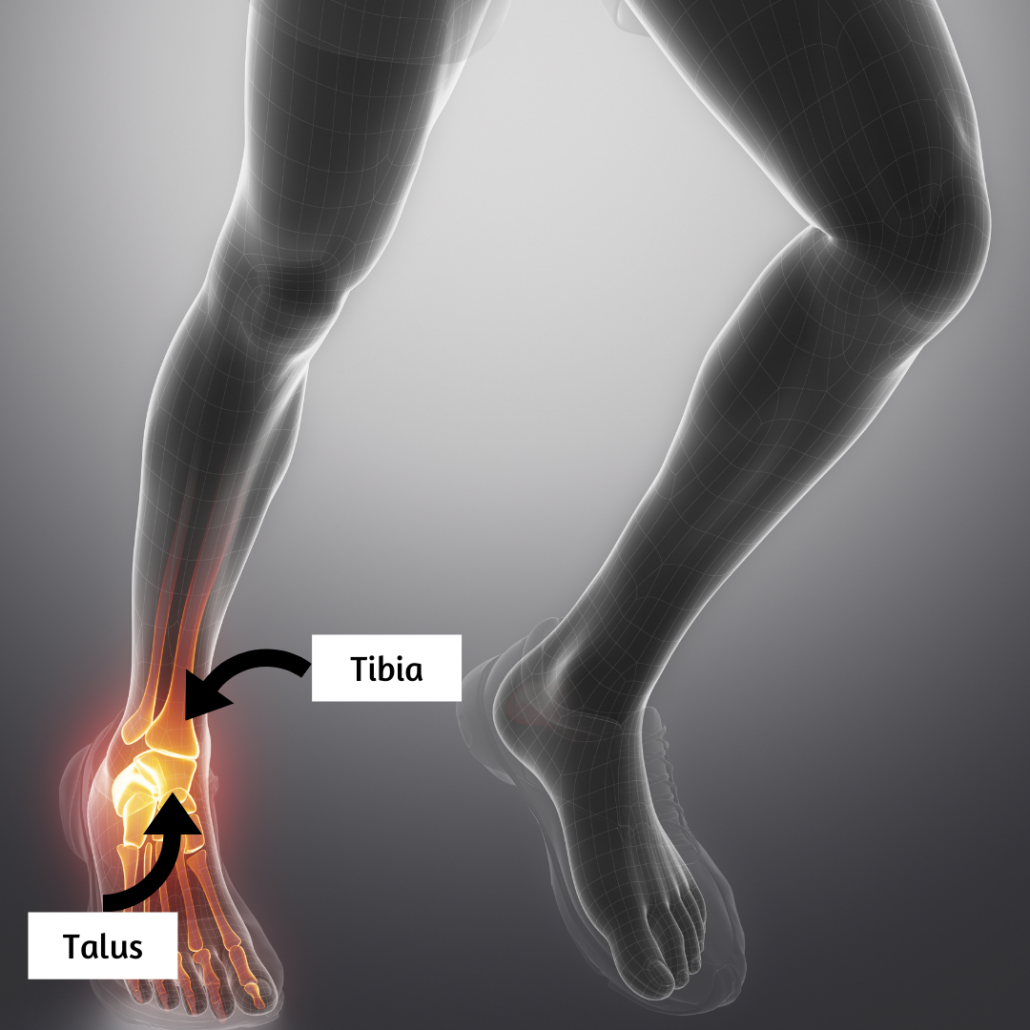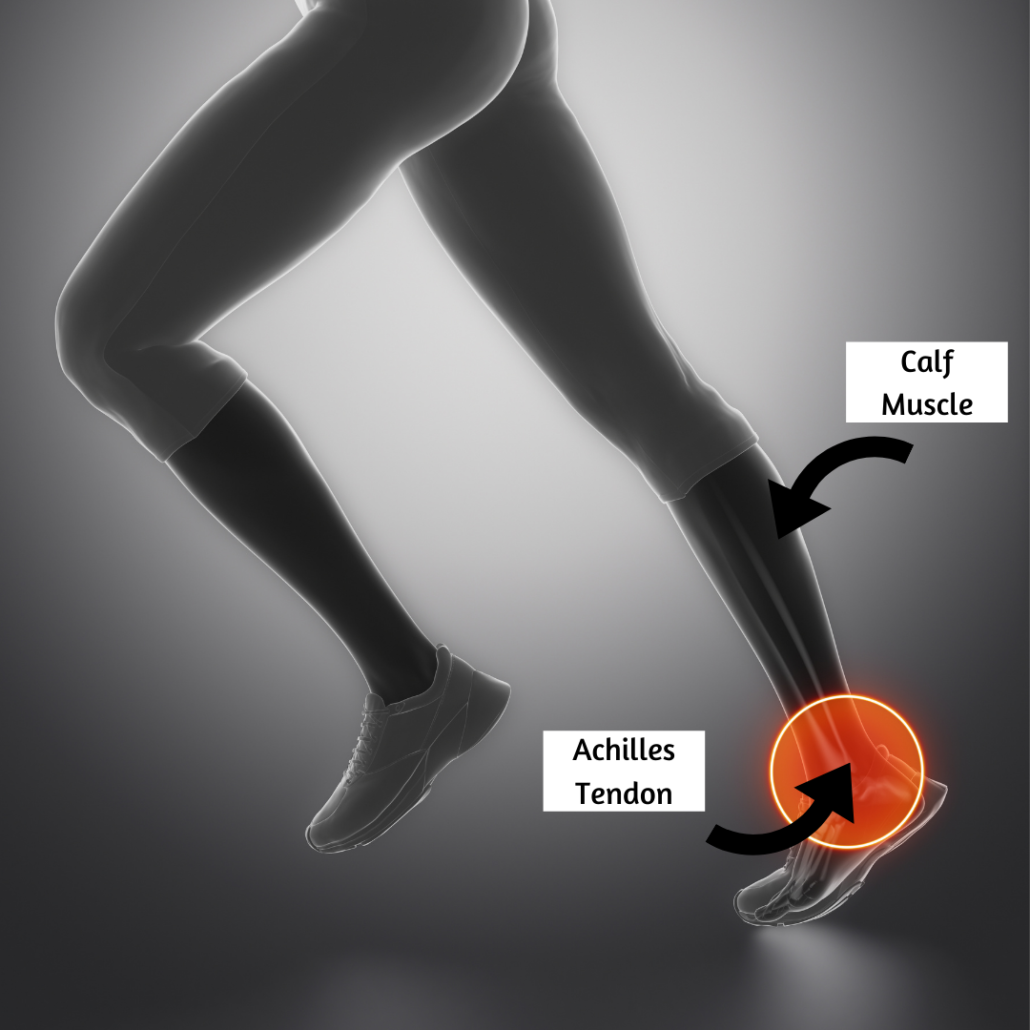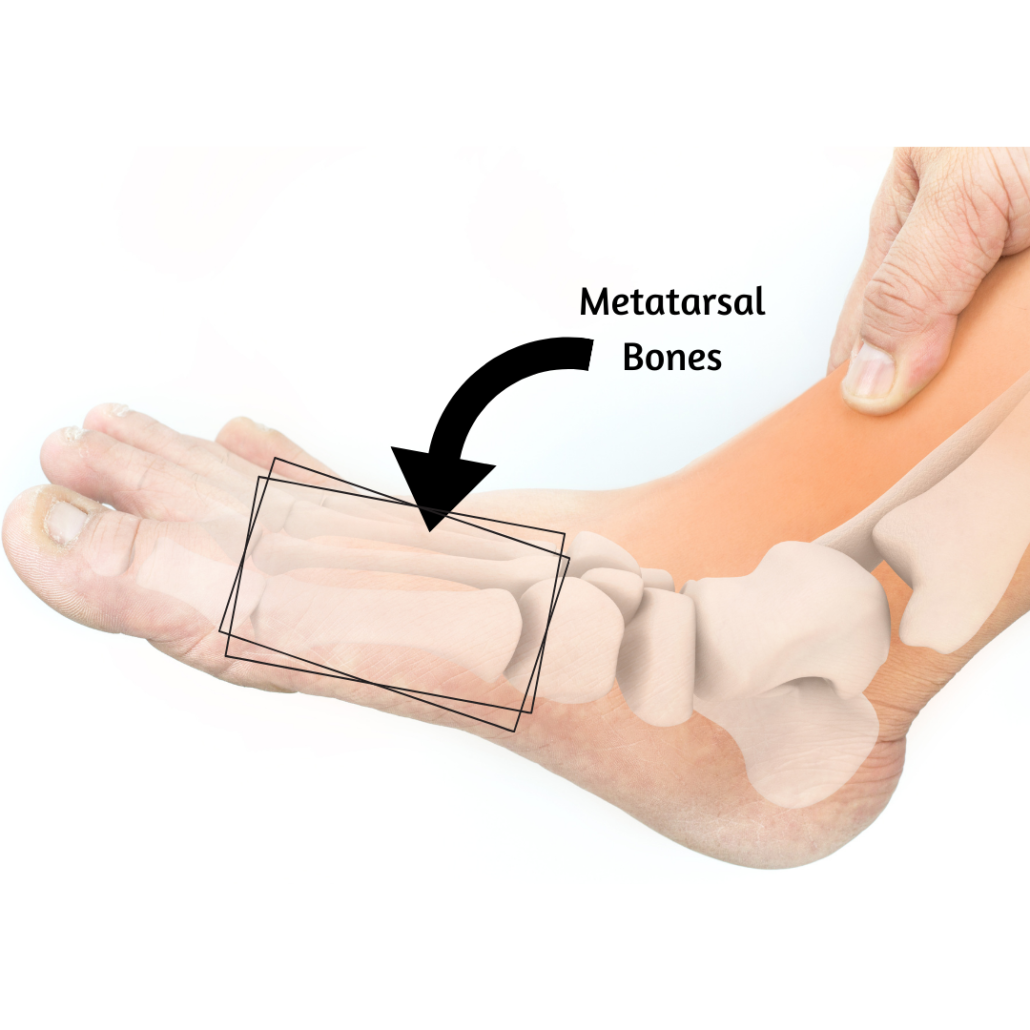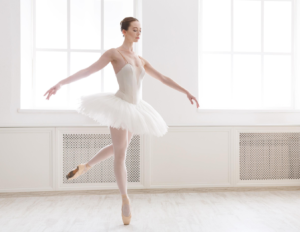Posts
More About Your Pointe Shoe
/in The Performing Arts, Uncategorized /by Dr. Alyssa Arms, PT, DPT, OCSFinding the right pointe shoe is a major part of a ballet dancer’s life. We learn how to sew the ribbons & elastics. We build relationships with our fitter, who may be local, fitting virtually, or a long trip away. We learn how to start dancing in the shoes, refining our technique.
With everything that we do learn when it comes to pointe, there are some things that we don’t really talk about or learn about. Keep reading to find out.
EXTENDING THE LIFE OF THE SHOE
Most dancers who dance en pointe should be doing at least a couple of hours of ballet per week, some of which will include pointe work. We all know that when we’re working, feet get sweaty. That moisture builds up in the shoes and can start to contribute to the breakdown of the material inside of a pointe shoe.
Watch the fascinating way pointe shoes are made in the video above.
If you’re only doing pointe for short periods 1-2 times per week, you probably get plenty of time for the shoes to dry out between uses, keeping your shoes in good shape for longer.
But if you’re dancing in the same shoes for multiple hours a week, you may want to consider having more than one pair of shoes to let each one have a chance to full dry between uses.
DIFFERENT POINTE SHOES FOR A DIFFERENT GOAL
Dancers are often on the hunt for the elusive “perfect fit” of their pointe shoes. It can take several tries of different brands, styles, and shoe characteristics to find what fits best.
But did you know that there can be more to it than that?
If you’re dancing en pointe quite a bit, it may actually be beneficial to have more than one pair of pointe shoes, not just for what we talked about in the section above. You may want a different shoe for different uses (performance vs class) or to let you work on different things (foot or core strengthening vs balance).
It’s not just about fitting the shoe to the foot – although that definitely is an important part!
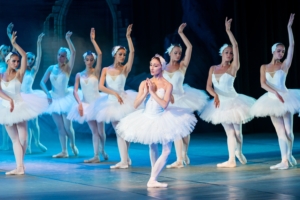
Let’s first talk about a couple of scenarios that you might encounter.
If you’re performing in a ballet with quite music, you don’t want loud shoes that you’ll hear from a mile away. You’d want something lighter, perhaps with a softer shank or a different material. Maybe you want a box that’s a bit more broken in. More pleats or a shoe that has a foam-like material built in can also help the shoe be quieter.
For a piece that requires a lot of pirouettes and balance on pointe, a harder shoe with a more substantial platform is helpful, as you’ll get more support.
Choose a shoe that best serves your purposes for a given performance or audition.
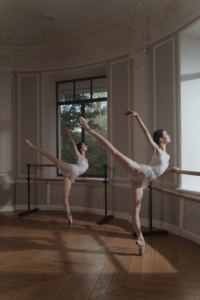
Now let’s talk a bit about how a couple of different shoe characteristics help you build strength, gently return to dance after an injury, or something else. These are just a few examples. Each element of a pointe shoe has its pros and cons for an individual dancer.
THE PLATFORM
A small platform is the hardest to balance on but requires less strength for rotation on the platform. Meanwhile, a large platform is easier to balance one but requires more strength for rotation.
A platform with rounded edges is easier to roll through smoothly but it’s harder to find the center of the box for balancing. This decrease in stability can more other muscles in the body, like around the hips & core, work harder to maintain alignment. A flat platform essentially has the opposite effect.
Then there are tilted platforms. These are fine if you have strong ankles. They’re not a good choice if your feet are more flexible or still need to build strength.
THE SHANK
A soft shank tends to be lighter and therefore quieter but don’t give as much support and are more likely to break in quickly. These shoes may be a good choice for a show, for example.
On the opposite end of the spectrum, a hard shank tends to be heavier and lower, but last longer. These are good for something like classes – able to hold up longer and get more wear.
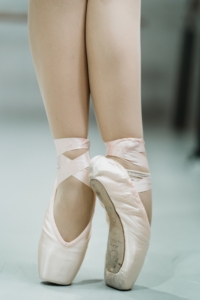
WORK WITH A PROFESSIONAL
At the end of the day, there are a LOT of things that need to be considered when it comes to finding the right pointe shoe.
You want something that feels comfortable and gives you the right support in the right areas. A good fitter will also consider things like foot structure or medical diagnoses. This could include bunions, more flexible feet, or whatever the case may be.
Talk with your fitter. Let them know if you’re struggling with an aspect of your current shoes. Let them know if you’re still returning from an injury. Talk about needing a quieter shoe for an upcoming performance. They’ll give you recommendations to find the right shoe for you and for your specific needs, whatever they may be.
You may also find some dance specialists in the health and wellness world, like Dr. Alyssa here at Back in Step PT, who have had training in at least the basics of pointe shoe fitting. These individuals can also make suggestions about certain characteristics to consider or to discuss with your fitter.
Book a session with us at Back in Step PT!
Is Your Dancer Ready for Pointe? A Guide for Parents
/in The Performing Arts, Uncategorized /by Dr. Alyssa Arms, PT, DPT, OCS It seems like one of the biggest things for young dancers growing up is the dream of dancing en pointe. And why not?! You get to have the beautiful shoes, the gorgeous tutus, and the chance to develop a whole new set of skills.
It seems like one of the biggest things for young dancers growing up is the dream of dancing en pointe. And why not?! You get to have the beautiful shoes, the gorgeous tutus, and the chance to develop a whole new set of skills.
This dream of dancing en pointe is great and a good goal to have, but some dancers or dance parents may be eager to start pointework before their teacher has made the recommendation. It may feel unfair that a dancer doesn’t get to start yet. Or maybe you’re not sure why the teacher is/isn’t giving a recommendation.
The goal of this post is to talk a little bit about what your dancer needs to have, from a medical perspective, to safely dance en pointe. We’ll also be addressing some of the myths around readiness and additional considerations.
Myth #1: You can automatically move to pointe once you reach a certain age.
FACT: Age is only one small part of everything that should be considered. Most recommendations from medical research suggest that the dancer is at least 12 years old – or maybe 11, in certain specific circumstances.
Why is that? A big part of it has to do with development of bones and joints.
We know that the bones of the foot finish developing someting between the late teens to early twenties, but it varies a lot from person to person. Besides that, we are also concerned about the dancer’s growth plates. This is the part of the bone (like the femur, or thigh bone) where a child’s growth happens. These close around 14 years old in females. We want to be closer to that age before starting pointe.
Myth #2: You can progress to pointe once you reach a certain level at your studio.
FACT: The truth is – this is partially true.
It’s not so much about reaching a certain level. This makes sense because different studios or training programs have different definitions of their levels, so it’s hard to compare from program to program.
The biggest recommendation here is actually related to amount of training. Generally, we recommend 3-4 years of ballet-specific training. This means that other dance styles or mixed classes (like a ballet/tap combo class) do not count towards that total. Some recommendations even say that it should be 3-4 years after the age of 8!
Besides the recommendation of 3-4 years, we also recommend 2-3 hours of ballet classes per week.
Myth #3: Once you’re on pointe, there no need to ever go off again, except if you have a major injury.
FACT: Of course injury or pain is an excellent reason to take a break from pointe! But we want to challenge you to think about another time when it may be beneficial.
Consider also taking a temporary break when the dancer is going through a growth spurt. During this time, the muscles and strength, as well as control and coordination, are all trying to catch up with one another. We even know that some muscles need to work up to 40% harder during this time, at least until everything is back on the same track.
During this time, dancers can focus on developing their strength and control again. They can continue working on demi-pointe and can focus on a strengthening program. Once they’re feeling more coordinated again and aren’t experiencing some of the growing pains, it can be safe to work back into their pointe work.
Hopefully this helps dispel some of the most common rumors about when dancers are or aren’t ready for pointe!
Now for some additional considerations:
-
What does the research say?
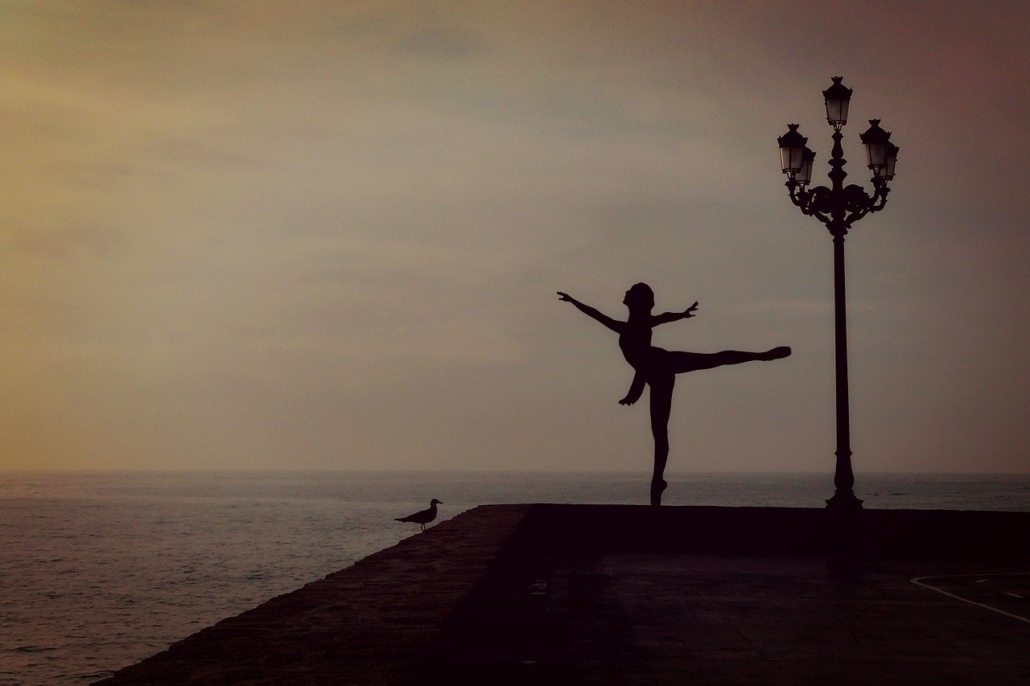 An interesting fact: working on demi-pointe puts up to 4 times your body weight through your foot. Once you’re working on full pointe, it can put up to 12 times your body weight through your foot! That is yet another reason why it’s crucial that dancers are truly ready for pointe and not starting too early.
An interesting fact: working on demi-pointe puts up to 4 times your body weight through your foot. Once you’re working on full pointe, it can put up to 12 times your body weight through your foot! That is yet another reason why it’s crucial that dancers are truly ready for pointe and not starting too early.
There are some tests that your dance teachers and/or dance medicine professional can do to assess readiness even more specifically (and we highly recommend this).
Some easy ones to do in the studio are things like the pencil test, airplane test, topple test, and single leg sauté test.
Besides that, it’s also great to have some strength and joint motion test done, which can be done by a dance medical professional. For a very thorough assessment, we also recommend the medical professional look at things like injury history, training habits, general health, nutritional practices, and more.
-
Should my dancer get an xray to check their growth plates?
No. You may often hear this recommendation from dance instructors but research actually shows little evidence that this is helpful information. Seeing the growth plate “closed” on the xray does not necessarily mean that the bones are mature.
So if you do get the xrays done, not only is it not the most reliable information, but you’re spending money on it and your dancer is getting exposed to radiation unnecessarily.
-
When should we seek out a dance medicine professional?
If your dancer:
-
-
- is complaining of pain for longer than a week, or it is accompanied with swelling, loss of joint motion, numbness, or instability.
- has pain that wakes them up at night, is present at the start of activity, or gets worse with activity.
- seems to be frequently injured or if they seem to take a long time to recover.
- is showing an imbalance in flexibility, strength, or control from side to side.
- is hyperflexible.
-
And, of course, seek out a dance medicine professional for things like pointe readiness assessments, annual dancer physicals, injury screenings, fitness programs, and other prevention and wellness services. Find out more about ours here.
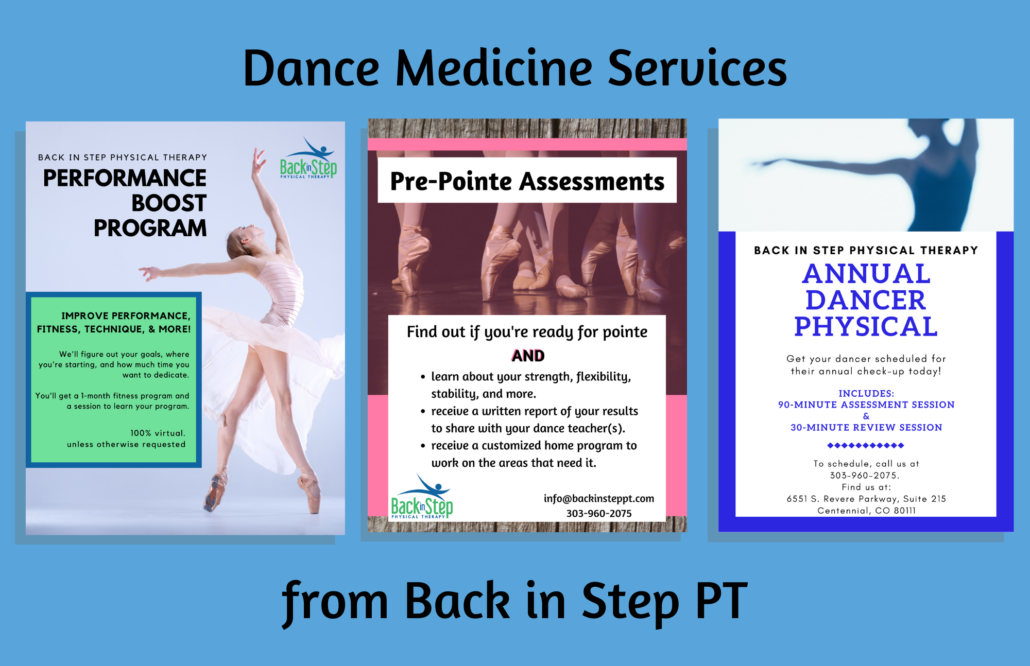
Check out our video about it on our YouTube channel!
Dancers’ Great Superpower
/in The Performing Arts, Uncategorized /by Dr. Alyssa Arms, PT, DPT, OCS Dancers are very aware of their bodies! They absolutely need this awareness for a routine either in class, rehearsal, or on stage. However, dancers tend to ignore their injuries due to the very real fear of not being able to keep doing what they love. Dancers should use their “hyperawareness of their bodies” superpower for good to ultimately prevent future, harmful dance injuries! How are they able to do this?
Dancers are very aware of their bodies! They absolutely need this awareness for a routine either in class, rehearsal, or on stage. However, dancers tend to ignore their injuries due to the very real fear of not being able to keep doing what they love. Dancers should use their “hyperawareness of their bodies” superpower for good to ultimately prevent future, harmful dance injuries! How are they able to do this?
Well, we’ll tell you!
Through education of common dance injuries, importance of dance injury prevention, and importance of seeing a dance medicine physical therapist (PT) when experiencing symptoms of these common dance related injuries, dancers can use their superpower to keep them happy and healthy and doing what they love!
Dancers are the most hardworking and dedicated athletes out there! However, this hardworking and dedicated nature is what often leads to dance related injuries. These injuries could be overuse injuries or acute injuries, resulting in dancers having to sit out for rehearsals and performances. We have a list of five of the most common dance related injuries and their signs/symptoms to look out for.
Hip Impingement 1,2
What is Hip Impingement?
Hip impingement is when the bones of the hip joint become close together due to repetitive motions dancers do in class. You have two bones that make up your hip joint: the acetabulum and head of the femur.
As the hip joint moves when doing big movements, such as grand battements, your two bones collide more with one another. This places more pressure on the hip joint and can lead to hip pain.
Superpower Sense for the signs and symptoms of hip impingement
Pain in the following positions:
-
-
- Hip flexion (i.e. when you do a battement)
- Internal rotation (i.e. when you turn in)
- Passé
- Developpé a la seconde
-
Patellofemoral pain syndrome 1,3
What is patellofemoral pain syndrome?
Patellofemoral pain syndrome, also known as “runner’s knee,” is a common knee injury leading to pain under and around the patella or “kneecap.” There are unknown causes of patellofemoral pain syndrome, but we do know that it can be due to muscle imbalance. Muscle imbalance means that one muscle surrounding the knee joint is overworking while another is underworking.
Are you a dancer who thinks they have patellofemoral pain syndrome? Well we can help! Check out this link to our Pain in the Plié program that can help dancers manage their knee pain.
Superpower Sense for the signs and symptoms of patellofemoral pain syndrome
Pain in the front or around the knee in the following positions:
-
-
- Jumping
- Pliés
- Going up stairs
-
Ankle impingement 1,4
What is ankle impingement?
Your ankle joint is made up of two major bones: distal tibia and talus. There are many different structures that surrounds this ankle joint, such as muscle, tendons, and ligaments.
Ankle impingement is pain in either the front or back of the ankle due to these surrounding structures getting compressed. This compression happens in dancers because dancers have to move their ankles through extreme motions during class, rehearsal, and performances. Maximally flexing or pointing your foot or going onto relevé on pointe throughout class can put dancers at risk of developing ankle impingement.
Superpower Sense for signs and symptoms of ankle impingement
Pain in the front of the ankle with the following positions:
-
-
- Plié
- Landing from any type of jumping movement
-
Pain in the back of the ankle with the following positions:
-
-
- Tendu
- Relevé
- Any position where the foot is maximally pointed
-
Achilles tendonitis 1
What is Achilles tendonitis?
The Achilles tendon is the tendon of the calf muscle that attaches to the heel bone, or the calcaneus. The calf muscle is responsible for pointing the foot, a controlled relevé, and “quiet” landing from a leap.
Achilles tendonitis is a common overuse injury in dancers where the Achilles tendon, or calf tendon, becomes inflamed and irritated. This could be due to excessive training or using the incorrect muscles when dancing. To learn more about preventing Achilles tendonitis and other related injuries, check out this link to our previous blog post on the hot topic of stretching before dancing.
Superpower Sense for signs and symptoms of Achilles tendonitis
Pain in the back of the ankle, just above the heel that may feel better after warm up, but worse with the following:
-
-
- Pointe work
- Jumping
- Pointing the foot
-
Stress Fracture 5
What is stress fracture?
A stress fracture means that there is a small fracture within a bone because of an increased stress to the body. Stress fractures are commonly associated with increased intensity or volume of training workload, such as several, 8 hour (or longer) rehearsals leading up to a big performance or competition. In dancers, these stress fractures occur in the bones throughout the legs, ankles, and feet. The most common stress fracture for dancers are the in metatarsals, or the long bones in the middle of the feet.
Superpower Sense for signs and symptoms of stress fracture
-
- Pain during dancing but subsides with rest
- Pain gradually worsening over time when continuing to put weight through the painful area
- Swelling and tenderness around the painful area
Go Out and Conquer that Stage!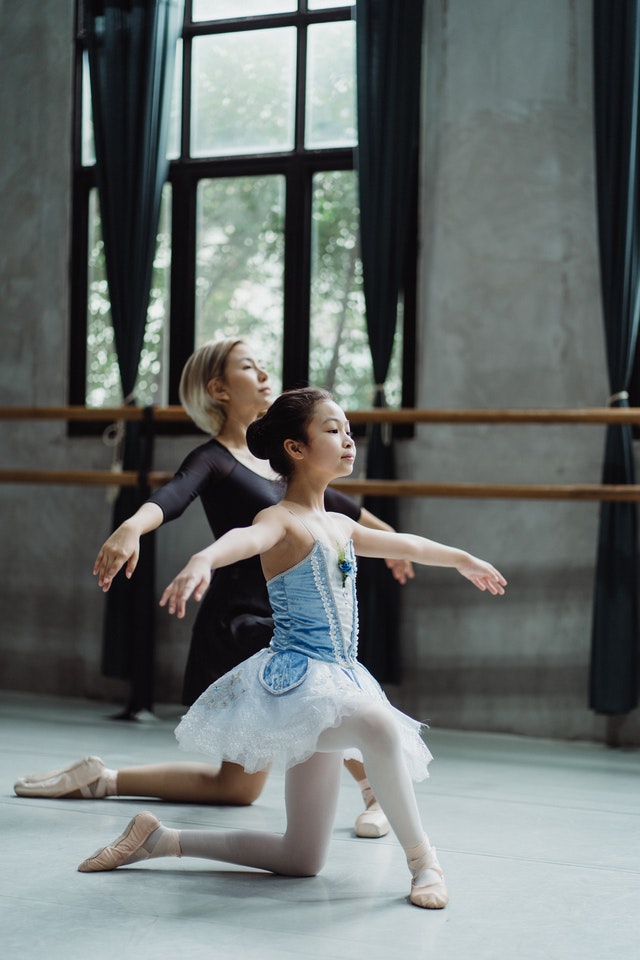
Now that you’re familiar with some of the most common dance related injuries, it is time to put your superpower to the test!
Make sure to keep an eye out for the signs and symptoms of these injuries so that you can take good care of your body. Don’t let that injury linger or think that the injury will just disappear. Seeing a dance specialist PT will help you manage your pain sooner and help you understand more ways you can protect your body from injury now and in the future. So, start using that superpower of understanding your body to keep on killing it in today’s and future classes, rehearsals, and performances!
Give us a call at Back in Step Physical Therapy to get started on your journey to wellness with a dance medicine specialist.
Also check our our Dancer’s Kit!
Guest Blog by Marissa Holliday, SPT
Marissa Holliday is a second year Student Physical Therapist at the University of Colorado-Anschutz Medical Campus. Marissa has a background in various styles of dance (jazz, contemporary, lyrical, tap, ballet, and hip hop) and is no stranger to dance injuries. She currently works as an intern for Back in Step Physical Therapy, and is excited to learn more from Dr. Alyssa Arms on working with this amazing dancer population as a future physical therapist.
References
- Krysten Malcolm DPT. 7 Common Dance Injuries (and How to Prevent Them). neurotour. https://www.neurotour.com/blog/7-common-dance-injuries. Accessed November 28, 2020.
- Hip Impingement. Johns Hopkins Medicine. https://www.hopkinsmedicine.org/health/conditions-and-diseases/hip-impingement. Accessed November 28, 2020.
- Paul Ingraham • updated Nov 14 2020. What Works for Patellofemoral Pain? What Doesn’t? Why? www.PainScience.com. https://www.painscience.com/tutorials/patellofemoral-pain-syndrome.php. Published November 14, 2020. Accessed November 28, 2020.
- Ankle Impingement. Physiopedia. https://www.physio-pedia.com/Ankle_Impingement. Accessed November 28, 2020.
- Stress Fractures. Physiopedia. https://physio-pedia.com/Stress_Fractures?utm_source=physiopedia. Accessed November 28, 2020.
Warm Up like the Australian Ballet!
/in The Performing Arts, Uncategorized /by Dr. Alyssa Arms, PT, DPT, OCSTrying to get your splits closer to the floor or your battements higher? Are you told to sit in front of the TV and stretch for long periods of time? It turns out that this may not be the best way to improve flexibility and performance while also preventing injury. The Australian Ballet agrees, and here’s why.
Static stretching may not always help and can cause harm.
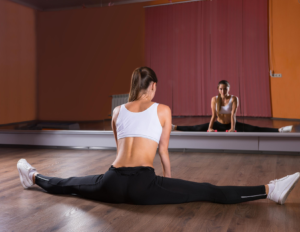
Dancers in the Australian Ballet were experiencing a lot of calf tears. Their physical therapists (PTs) wondered why this was the case. After changing their warm-up routine, the PTs found the culprit of these injuries to be static calf stretching.
What is static stretching? It’s when you hold a single position over a period of time, like this dancer sitting in her middle splits. For many years, it was thought that this was the best way to improve flexibility. But now that is changing. Besides, how often would you stay in a middle split while performing, auditioning, or competing?
The Australian Ballet used to do static calf stretching on a slanted board during warm-up for rehearsal or performances. Now, they’ve given their dancers a more dynamic form of calf stretching during warm-up. Because of this change, there was a significant decrease in calf tears within their company!
Strengthening muscle groups in a functional way is the key to success for dancers.
Dancers need a lot of strength when performing. This especially applies to something called “eccentric movements”. During an eccentric movement, the muscle is engaged but lengthening at the same time. For example, when a dancer performs a grand jeté, they use eccentric control of their calf when they land. Or when a dancer comes down from a relevé en pointe, they need good eccentric control to do it.
One way that the Australian Ballet works on this is by having thier dancers perform 24 one-leg heel raises at the end of each barre session, every day. As a result, they have seen a big decrease in ankle and calf injuries. These dancers may do thousands of single leg heel raises throughout a rehearsal or stage performance. By doing this set of heel raises at the end of barre, dancers’ muscles are primed for correctly using this motion throughout their rehearsal or performance. This ultimately decreases dancers’ risk for future injury.
Dancers must have the strength to perform powerful movements.
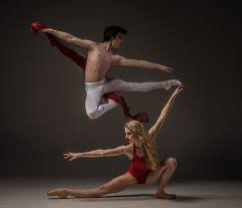
Besides switching from static stretches to more dynamic movement, the Australian Ballet also added a focus on strengthening deep core stabilizers and key power muscle groups. This has helped the dancers get their battements higher with more ease and prevent future injuries.
The deep core stabilizers protect the spine and provide stability of the torso. By activating these muscles, dancers won’t overcompensate with other muscle groups. Dancers can better protect their joints, muscles, and ligaments through using these deep muscles. Strengthening of the key muscle groups also gives dancers the power they need to do their amazing battements, turn sequences, and grand jetés.
Static stretching of these muscles for long periods of time can actually lead to them becoming inactive and less effective! We wouldn’t want dancers jumping into a rehearsal or performance with inactive muscles, since it could lead to significant injuries. So before dancing, dancers in the Australian Ballet activate their deep core and key power muscles. We call this “muscle priming”. Muscle priming wakes up key muscles that dancers need to give a beautiful performance while keeping them injury-free.
Our Recommendation
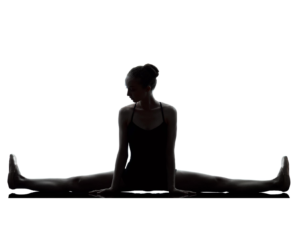
The dancers from companies like the Australian Ballet have seen the benefits of changing their warm-up routines, getting rid of static stretching and adding in muscle priming activities. And we agree with this concept! Dancers should do muscle activation exercises instead of static stretching or foam rolling before class, rehearsal, and a performance.
So next time you think about sitting in front of the TV in your middle splits, think again! Remember the importance of dynamic stretching, functional strengthening, and strengthening of certain muscle groups to ultimately improve your performance and keep you safe!
For more information on stretching, check out this link to our previous blog post. And if you’re looking for help to make these positive changes for yourself or your dance students, contact us. We love working with our dance community to keep everyone happy and healthy!
Also check our our Dancer’s Kit!
Click this link to check out the full article on why the Australian Ballet stopped stretching.
Guest blog by Marissa Holliday, student physical therapist.
Back In Step Physical Therapy
6551 S Revere Pkwy, Ste 215
Centennial, CO 80111
(303) 960-2075
info@backinsteppt.com
